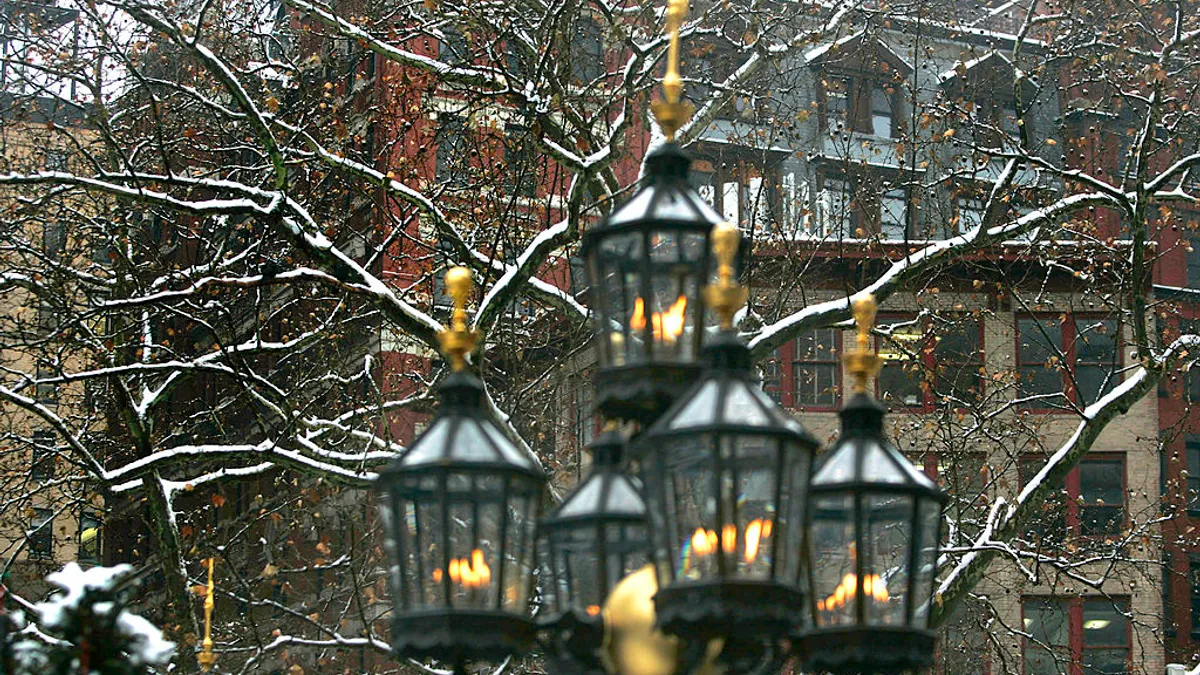Dive Brief:
- Boston is in the midst of a community engagement process to collect feedback on its plans to convert 2,800 of the city’s remaining gas lamps to LED lights.
- The process began earlier this month when the city retrofitted a gas streetlight to electric in the historic Bay Village district. The move received some pushback from local residents who are passionate about preserving the historic charm of the gas-lit lights. The city contends though that the retrofit “keeps the same historic lighting fixture with updated LED bulbs to maintain Boston's historic integrity while reducing our carbon emissions,” a mayor’s office spokesperson said.
- The initial conversion is also the beginning of an effort to conduct a citywide audit of Boston’s lighting to reduce its carbon footprint and save money. The city pays nearly $1 million annually in gas bills to cover gas-lit streetlights, in addition to about $200,000 for annual maintenance. Meanwhile, only 4% of the city’s street lights are gas-lit, but they are responsible for 37% of streetlight emissions, according to the mayor’s press office.
Dive Insight:
Gas lamps date back to the late 1700s, first debuting in the U.S. in Baltimore in 1817. By the 20th century, most streetlamps had been replaced with electric light bulbs.
But some U.S. neighborhoods are still hanging on as the last bastions of gas streetlights. Cincinnati, for example, is home to a gaslight district and parts of New Orleans’ French Quarter are also illuminated by the old-school lighting source.
Though the gas lamps can be charming, they produce a hefty carbon footprint. Two Boston gas lamps consume as much gas each year as an average house according to the Massachusetts Department of Energy Resources' Energy Policy Planning and Analysis Division. Meanwhile, the mayor's press office said that annual emissions of an existing gas lamp pole are 41 times greater than that of "a 36W LED replacement."
"Right now, the charm and character of our gas-lit neighborhoods comes at a cost to the planet. Switching to LED is how we preserve our past while protecting our future," Boston Chief of Streets Jascha Franklin-Hodge wrote in a tweet.
Just two gas lamps use as much fuel as an average house in MA, and swapping all of them for LED would be the equivalent of taking 1,100 cars off the road. (Data via @BostonEnviro, our partner in this work.) pic.twitter.com/7TJU7x7jVZ
— Jascha Franklin-Hodge (@jfh) March 14, 2022
The city’s lighting system must be decarbonized to achieve its goal of carbon neutrality by 2050, the mayor’s press office said.
"In reimagining our City’s historic streetlights, we have an opportunity to take an important step toward becoming a Green New City, while preserving the historical integrity that shapes Boston’s character,” Boston Mayor Michelle Wu said in a statement to Smart Cities Dive. “Together with our communities, we’re excited to explore how these electric street lamps can serve as an innovative tool in the fight against the current climate crisis.”
To date, about 58,000 of the city’s electric lights have been converted to LEDs. The mayor's press office also said it is conducting a “limited exploration of smart lighting applications” among non-historic streetlights. Other cities like Philadelphia and Fullerton, California, are also prioritizing LED streetlight conversions, as the lights are the “backbone” for deploying different sensors, according to Philadelphia Smart City Director Emily Yates.
Meanwhile in Boston, the city is continuing its engagement process and encouraging residents to share feedback about the conversion in a survey. The city's landmarks commission and public works department will also host a second community meeting at the end of the month.












